Download Magellanic Cloud Galaxies Worksheets
Click the button below to get instant access to these premium worksheets for use in the classroom or at a home.
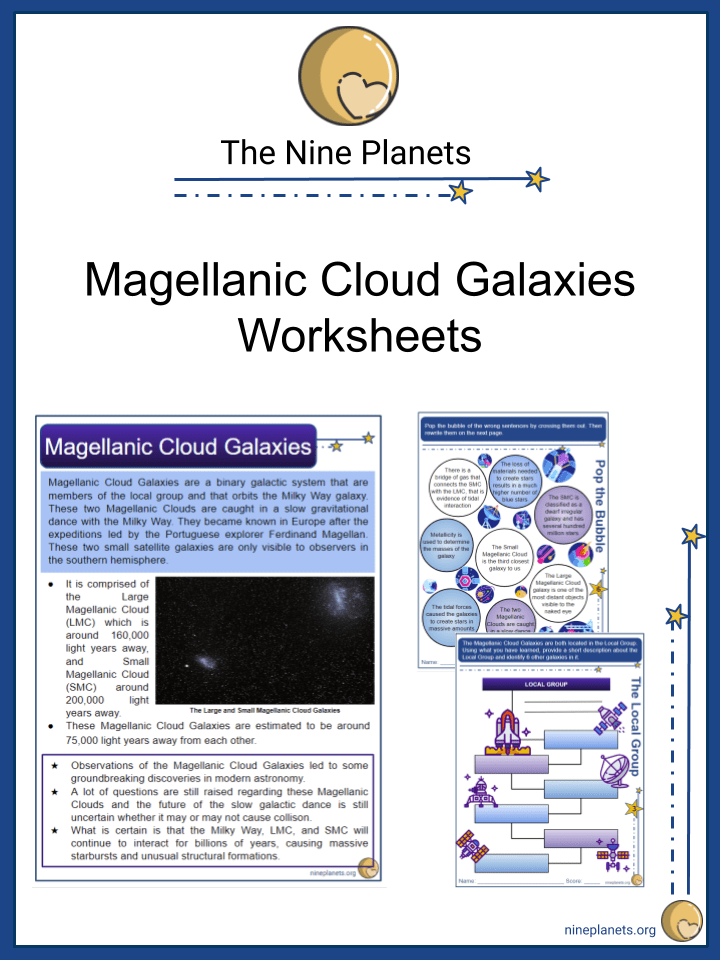
This worksheet can be edited by Premium members using the free Google Slides online software. Click the Edit button above to get started.
Download free sample
Not ready to purchase a subscription yet? Click here to download a FREE sample of this worksheet pack.
Resource Examples
Click any of the example images below to view a larger version.
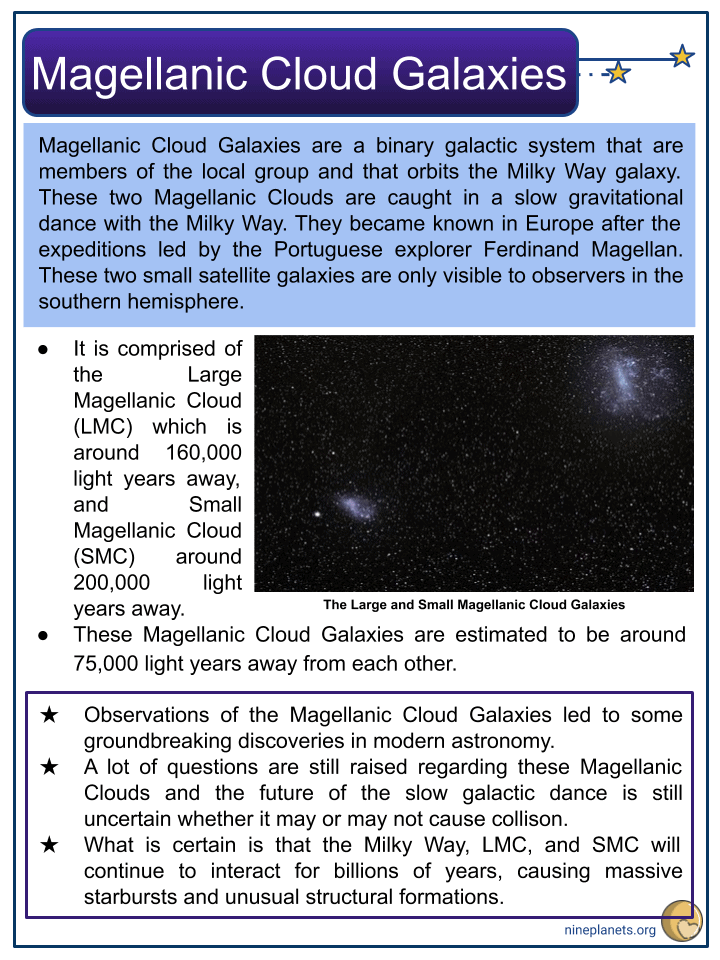
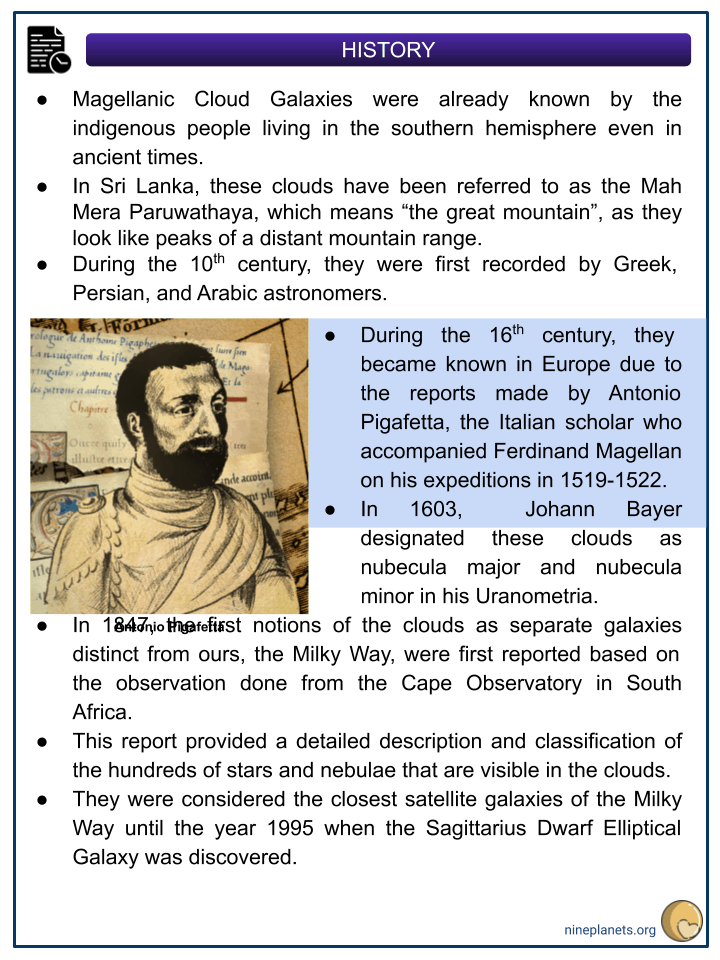
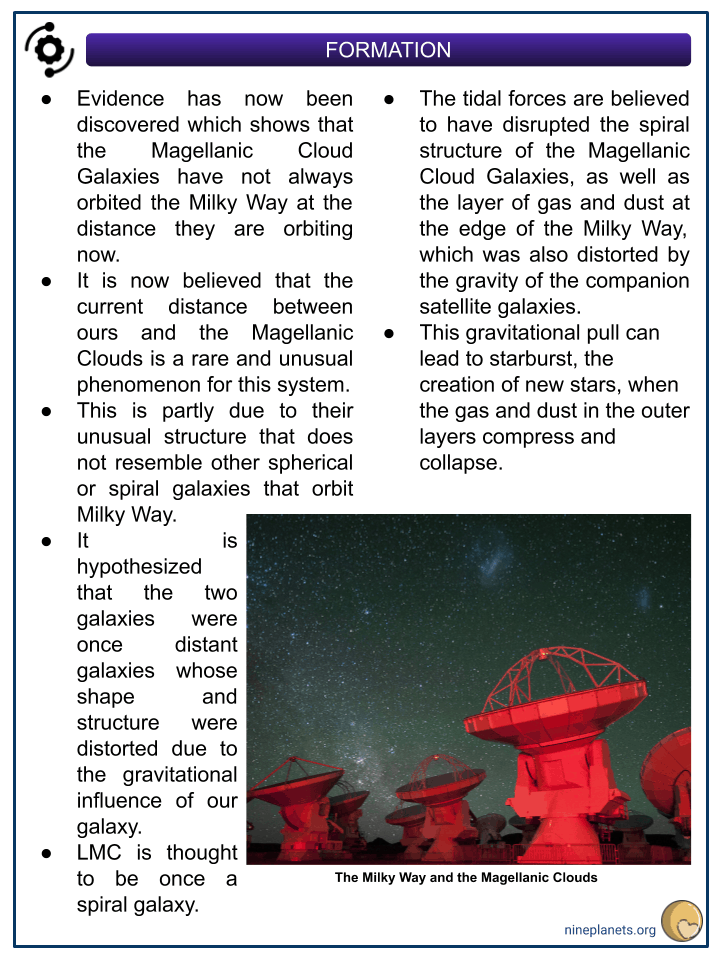
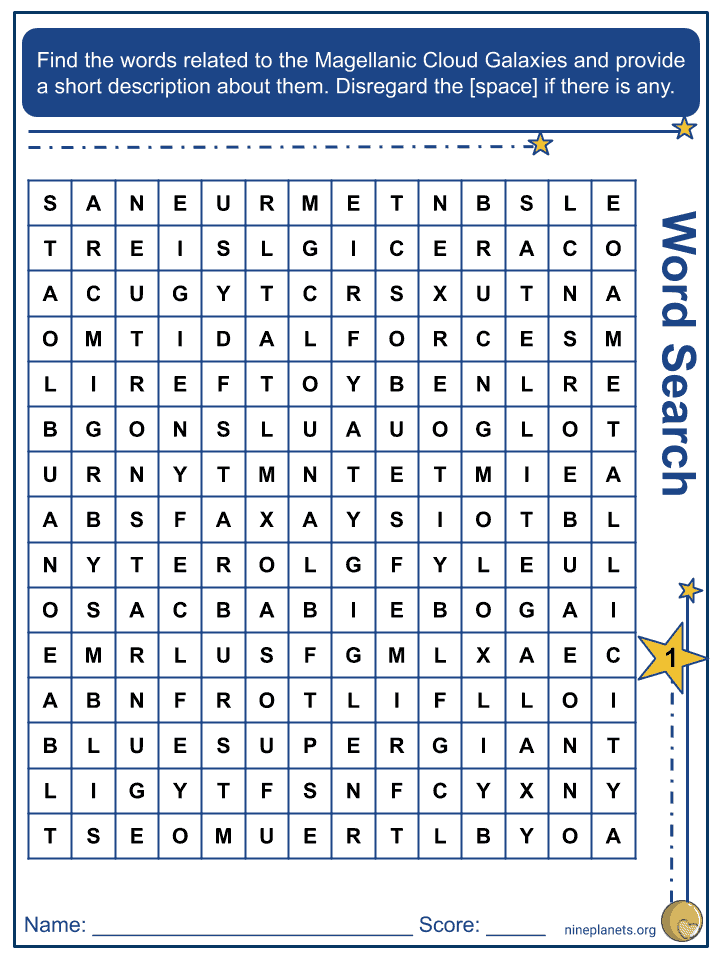
Key Facts & Information
- Magellanic Cloud Galaxies are a binary galactic system that are members of the local group and that orbits the Milky Way galaxy. These two Magellanic Clouds are caught in a slow gravitational dance with the Milky Way. They became known in Europe after the expeditions led by the Portuguese explorer Ferdinand Magellan. These two small satellite galaxies are only visible to observers in the southern hemisphere.
- It is comprised of the Large Magellanic Cloud (LMC) which is around 160,000 light years away, and Small Magellanic Cloud (SMC) around 200,000 light years away.
- These Magellanic Cloud Galaxies are estimated to be around 75,000 light years away from each other.
- Observations of the Magellanic Cloud Galaxies led to some groundbreaking discoveries in modern astronomy.
- A lot of questions are still raised regarding these Magellanic Clouds and the future of the slow galactic dance is still uncertain whether it may or may not cause collison.
- What is certain is that the Milky Way, LMC, and SMC will continue to interact for billions of years, causing massive starbursts and unusual structural formations.
History
- Magellanic Cloud Galaxies were already known by the indigenous people living in the southern hemisphere even in ancient times.
- In Sri Lanka, these clouds have been referred to as the Mah Mera Paruwathaya, which means “the great mountain”, as they look like peaks of a distant mountain range.
- During the 10th century, they were first recorded by Greek, Persian, and Arabic astronomers.
- During the 16th century, they became known in Europe due to the reports made by Antonio Pigafetta, the Italian scholar who accompanied Ferdinand Magellan on his expeditions in 1519-1522.
- In 1603, Johann Bayer designated these clouds as nubecula major and nubecula minor in his Uranometria.
- In 1847, the first notions of the clouds as separate galaxies distinct from ours, the Milky Way, were first reported based on the observation done from the Cape Observatory in South Africa.
- This report provided a detailed description and classification of the hundreds of stars and nebulae that are visible in the clouds.
- They were considered the closest satellite galaxies of the Milky Way until the year 1995 when the Sagittarius Dwarf Elliptical Galaxy was discovered.
Formation
- Evidence has now been discovered which shows that the Magellanic Cloud Galaxies have not always orbited the Milky Way at the distance they are orbiting now.
- It is now believed that the current distance between ours and the Magellanic Clouds is a rare and unusual phenomenon for this system.
- This is partly due to their unusual structure that does not resemble other spherical or spiral galaxies that orbit Milky Way.
- It is hypothesized that the two galaxies were once distant galaxies whose shape and structure were distorted due to the gravitational influence of our galaxy.
- LMC is thought to be once a spiral galaxy.
- The tidal forces are believed to have disrupted the spiral structure of the Magellanic Cloud Galaxies, as well as the layer of gas and dust at the edge of the Milky Way, which was also distorted by the gravity of the companion satellite galaxies.
- This gravitational pull can lead to starburst, the creation of new stars, when the gas and dust in the outer layers compress and collapse.
- It is believed that the complex dance of Milky Way, LMC, and SMC may have resulted in the violent distortion of their internal structure.
- Both of the Magellanic Clouds seem to have structures similar to the other barred spiral galaxies.
Observations
- The Magellanic Clouds are bright due to the huge number of stars they hold.
- Unlike the other satellites of Milky Way which approximately contain 10 million stars, the SMC has around 3 billion stars and the LMS has 30 billion stars.
- The Magellanic Cloud Galaxies also seem strange due to the abundance of gas they contain, in that satellite galaxies usually lose a substantial portion of their gas to the larger galaxies they orbit.
- This loss of materials needed to create stars results in a much higher number of old red stars within the galaxy but the two galaxies have a lot of gas and have a much higher ratio of hydrogen and helium, thus, exhibit starburst.
- The larger fraction of their mass constituted of these gases indicates that LMC and SMC have much lower metallicity than our galaxy.
- In astronomy, elements that are heavier than helium and hydrogen are considered metals.
- Metallicity is the term used to describe the concentration of elements including carbon, nitrogen, oxygen, and neon, in the nebulae and galaxies.
- Metallicity is also used to determine their masses.
- Observations of the Large Magellanic Cloud using radio-telescopes revealed a clear spiral structure that is comprised of neutral hydrogen.
- The masses of Magellanic Cloud Galaxies are hard to determine but the LMC is probably the most massive galaxy in the Local Group.
- The Local Group is the galaxy group that includes the Milky Way and the Magellanic Cloud Galaxies.
- Other galaxies included in the Local Group are: Andromeda Galaxy, Triangulum Galaxy, Sagittarius Dwarf Galaxy, Draco Dwarf Galaxy, Ursa Minor Dwarf Galaxy, and Carina Dwarf Galaxy.
- The two galaxies both have red and blue stars, nebula, and regions of high concentration of stellar formation.
- The young blue stars in the SMC are found to be only a few hundred million years old.
- The LMC contains the Tarantula Nebula, which is one of the most luminous non-stellar objects and one of the most intense starburst regions in the galaxy.
- It is a remnant of an explosion 160,000 light years away from us.
- The LMC is also a host galaxy to a supernova which is SN 1987A, the brightest observed in over 4 centuries.
- It was detected in Chile by the Las Campanas Observatory and revealed gamma-ray line radiation.
- The discovery of this violent explosion reveals that the blue supergiants can also cause a supernova event, which was in contrast to the predictions of stellar evolution models at that time.
- Other observations suggest that it might be due to the collision of the blue supergiant with a companion star in a binary system.
- Also, this explosion lacks a neutron star at its center, wherein when the star collapses in a supernova, its outer layers are scattered across the surroundings and a neutron star usually forms in the center.
Large Magellanic Cloud
- The Large Magellanic Cloud Galaxy is approximately 160,000 light years away from us.
- It is the third closest galaxy to our Milky Way, after the Sagittarius Dwarf Spheroidal Galaxy and the Canis Major Overdensity.
- The LMC approximately has a mass of around 10 billion solar masses and has a diameter of around 14,000 light years, which makes it the fourth largest galaxy in the Local Group.
- This galaxy is bright and has an apparent magnitude of 0.9.
- The Large Magellanic Cloud is classified as a Magellanic spiral galaxy.
- It contains a stellar bar which is geometrically off-center, suggesting that it was a barred dwarf galaxy and its spiral arms were disrupted probably by the tidal interactions from the Small Magellanic Cloud Galaxy.
- The measurements from the Hubble Space Telescope in 2014 were used to determine the rotation period of LMC which is 250 million years.
- American astronomer Robert Burnham Jr. described it as an “astronomical treasure-house, a great celestial laboratory for the study of the growth and evolution of the stars”
- The galaxy is estimated to roughly have 60 globular clusters, 400 planetary nebulae, 700 open star clusters and thousands of giant and supergiant stars.
Small Magellanic Clouds
- The Small Magellanic Cloud is approximated to be around 200,000 light years away from us.
- It is classified as a dwarf irregular galaxy and has several hundred million stars with an apparent magnitude of 2.7.
- It has a total mass of approximately 7 billion solar masses and a diameter of about 7,000 light years.
- The SMC has a central bar structure in which astronomers speculate that it was once a barred spiral galaxy that was disrupted by the Milky Way.
- The Small Magellanic Cloud Galaxy is one of the most distant objects visible to the naked eye.
- There is a bridge of gas that connects the SMC with the LMC, that is evidence of tidal interaction between the two Magellanic Clouds.
- Using the Dark Energy Survey and MagliteS data, a stellar over-density associated with the Small Magellanic Cloud was discovered in 2017, which is probably due to the interactions between the two galaxies.
Mini Magellanic Clouds
- Astrophysicists Mathewson, Ford, and Visvanathan proposed that the SMC may in fact be split in two.
- There might be a smaller section of this galaxy behind its main part, and separated by about 30,000 light years.
- It is suggested that MMC might be a result of the past interaction with LMC that split the SMC, and that the two sections are still moving apart.